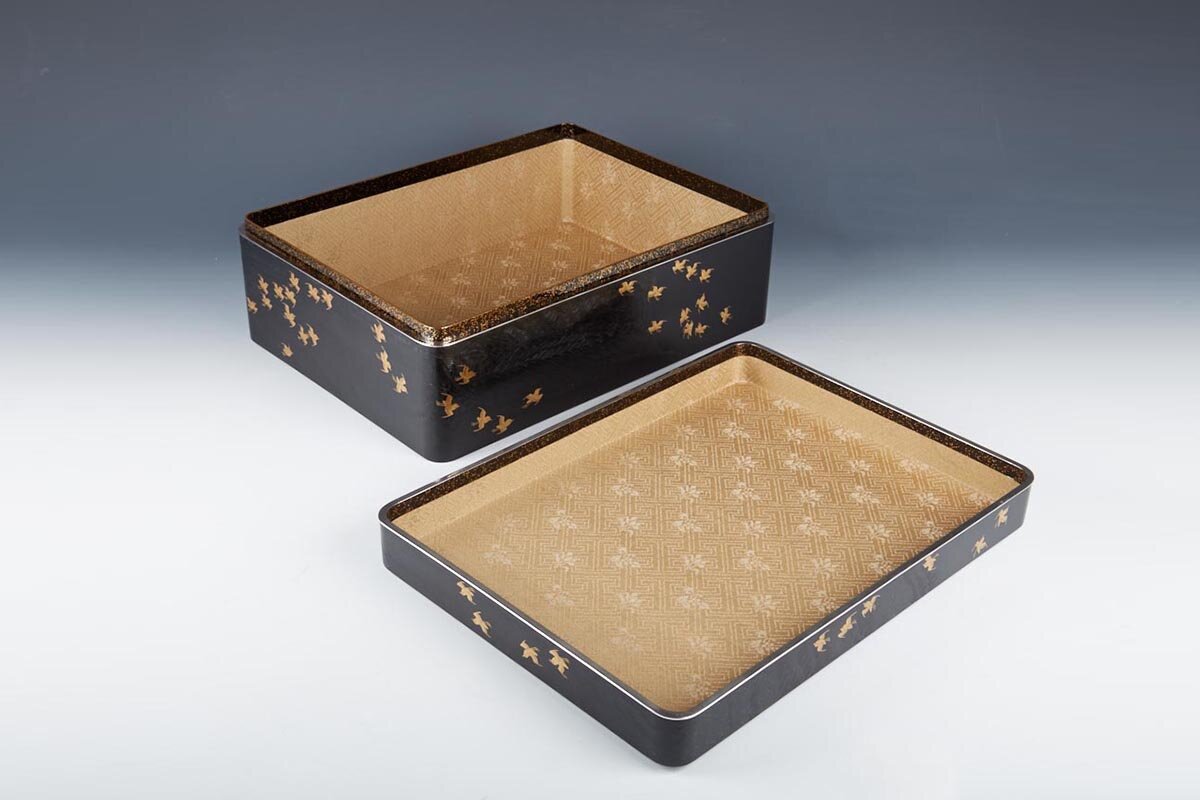MEIJI-TAISHO
LACQUER TEBAKO BY SHIMANO SANSHU
Tebako or ornamental cosmetic box in a rectangular form with rounded corners and lightly beveled upper edges, ornamented on the exterior with gold plovers flying over stylized waves. Of black and gold takamaki-e or raised lacquers, the water textured with combing in higher relief than the roiro or mirror-polished black sky; the reverse finished in gold nashiji flake lacquer on a roiro ground; the interior lined with floral-sprigged, gold silk brocade. With applied silver mounts. By Shimano Sanshu (Shimano Sanshu, the go or art name of Shimano Shintaro, 1877 – 1965). Taisho era, circa 1912 – 1926.
With the tomobako or original box, inscribed on the exterior of the lid: Chidori Maki-e Seikai Ha Tebako or Ornamental Cosmetic Box (ornamented with) Gold Lacquer Plovers (against) Blue Sea Waves; then signed: Sanshu Kaku or Sketched by Sanshu, and sealed. With the original tomogire or white silk wrapping cloth sealed by the artist.
Born in Kanazawa in July of 1877, Shimano Sanshu graduated from the lacquer department of the Ishikawa Kenritsu Kogyo Gakko (the Ishikawa Prefectural Crafts School). He also studied lacquer arts under Matsuoka Yoshiro and painting with Kishinami Ryukei.
In his early 20s he is said to have participated in one of the great expositions in America, winning a prize for his entry (Chicago is mentioned for 1898 when he was 21, but the World’s Columbian Exposition was held in 1893, when he was only 16, so alternatives are: Omaha’s Trans-Mississippi Exposition in 1898; San Francisco’s Golden Jubilee in 1898; or most likely, a venue with a large Japanese group of exhibitors, St. Louis’s Louisiana Purchase Exposition in 1904, when he was 27). It was in 1904, as well, that he moved to Osaka where he made his home for the rest of his life. In 1925, he was part of the Japanese contingent to the International Exhibition of Modern Decorative & Industrial Arts, in Paris, France, where his entry also won a prize. The same year he exhibited in Belgium. In 1939, he showed at the New York World’s Fair, again taking home an award.
In 1934 (Showa 9), he was admitted to the Teikoku Bijutsuin (the Imperial Art Academy); and in 1941 (Showa 16) became a shinsain or judge of the Academy, granted at the same time mukansa status free of vetting as an exhibitor.
Shortly after the Imperial Art Exhibitions expanded to include the applied arts in 1927, Sanshu was invited to join the exhibitions. He first showed at the 11th Teiten in 1930; returning to the 12th – 15th Teiten in 1931 – 1934; the autumn Bunten Kansaten in 1936; the 1st – 3rd Shin-Bunten in 1937 – 1939; the Hoshukuten in 1940; the 4th – 6th Shin-Bunten in 1941 – 1943; and the last Imperial exhibition prior to the end of the war, the Senji Tokubetsuten in 1944.
After the Pacific War, he returned to the national venues in 1951, showing at the 7th – 12th Nitten exhibitions from 1952 – 1956.
Shimano Sanshu created this tebako to suggest the repetitive abstraction of light rippling on the deep sea. Combing the higher relief waves in rippling sweeps, he textured the water crests in delicate taka-maki-e raised lacquers. This treatment contrasts dramatically with the mirror-black sky. The plovers flash gold in the light of the rising sun, wheeling with movement in great flocks against the pale sea and sky. As the artist’s unusual signature suggests, he felt he was sketching with lacquers, an unusually painterly point of view. Sanshu distills into three classical lacquer techniques three elemental qualities of night turning to day, painting for us an image at once still, eternal and alive with movement.
Lacquer Tebako by Shimano Sanshu
Artist Name: Shimano Sanshu
Period: Meiji Taisho
Mediums: Lacquer
Form: Ornamental Boxes
Origin Country: Japan
¼” high x 13 3/8” long x 10” wide
This piece is no longer available.





